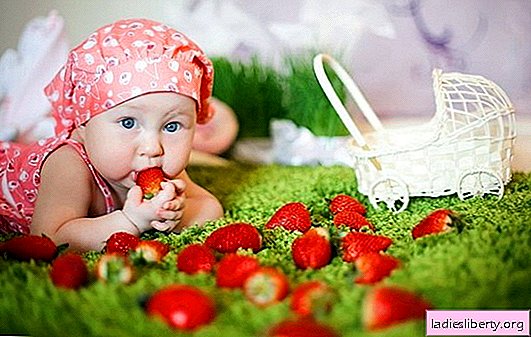
Nursing mothers should carefully monitor their diet and consume foods rich in vitamins and nutrients.
And nuts in this regard are one of the most controversial foods.
On the one hand, great health benefits, on the other - the threat of an allergic reaction.
So, is it possible to lactating nuts?
Health Benefits for Mom and Baby
Nuts are a source of very valuable and essential substances and vitamins for the body.
They include:
• minerals (phosphorus, potassium, calcium, magnesium, sodium, zinc, iron, copper, manganese);
• vitamins (A, C, E, B1, B2, B3, B5, B6, B9);
• vegetable proteins and amino acids;
• polyunsaturated fats (linoleic acid, Omega-3).
Nuts have a very beneficial effect on the female body, weakened by childbirth and feeding.
Mommy Health Benefits:
help fight depression after childbirth, fill the body with strength and energy;
prevent the development of mastopathy;
normalize the production of sex hormones, reduce pain during critical days;
have a diuretic effect, relieve swelling after childbirth;
slow down the aging process, protect against cancer;
improve the condition of hair and skin.
And through milk, beneficial substances from nuts enter the baby's body.
Health benefits of crumbs:
strengthening the heart and immunity;
calming effect on the nervous system, normalization of sleep;
the children's body receives all the necessary proteins and amino acids;
radiation protection, which is especially important, because now in all houses there is an abundance of household appliances that increase the background radiation.
Thus, the answer to the question "Is it possible to lactating nuts?" - positive, it is possible and necessary. The inclusion of nuts in the diet of a nursing mother will significantly strengthen her health and the health of the baby. But let's talk about the rules of their use further.
The effect of nuts on lactation
Can lactating nuts to improve lactation? It is widely believed that eating nuts increases the amount of milk produced. But this is not confirmed by any scientific research. But nuts significantly affect the quality of milk.
The fat content and nutritional value of breast milk increases, which is especially useful if the baby is weak and poorly gaining weight. But at the same time, the density and viscosity of milk increases. In some cases, the crumb may not like this and cause him difficulties with the process of sucking, up to giving up the breast.
In addition, the increased viscosity of milk can lead to stagnation in the milk ducts.
Is it possible to nursing nuts - how, what and how much
Excessive consumption of nuts can harm both the baby and mom. You can not eat nuts in unlimited quantities and when you want. So that they bring only benefits, follow certain rules:
1. Begin to eat nuts carefully. First eat 1-2 peanuts and carefully monitor the baby for a couple of days: if breathing is difficult, a nasal congestion appears, a rash or digestive problems begin (colic, upset, or, conversely, constipation), it means that there are no more peanuts.
2. Even if the baby does not have an allergic reaction, still do not eat nuts in large quantities - due to the fact that they significantly increase the fat content of milk, the baby may have indigestion.
3. Eat nuts in their pure form - do not fry them in oil, do not add sugar and spices, also under the ban nut jam, butter, pasta and sweet walnut topping of confectionery. All this can cause colic in the baby.
4. Before using, slightly bake the nuts in the oven or in a frying pan (but without adding oil) - this will make them tastier and relieve molds that may be on nuts.
5. Before adding nuts to your diet, consult your pediatrician. If you already have an allergy to something, then visit an allergist.
Depending on the type of nuts, their daily norm also varies.
Is it possible for nursing nuts - in what quantity:
• walnuts - 1-2 nuts per day;
• pine nuts - start with 1 tbsp. l cores, but not more than 10 g per day. If an allergy does not appear, then gradually you can increase the daily rate to 80-100 g;
• almonds - eat no more than 10 grains per day (20-30 g) and no more than 3 times a week. If there are cracks on the grains, this means that the almonds are old. It is better to refuse such nuts, they will not bring special benefit to you or to the baby;
• hazelnuts - no more than 20-30 g per day, but only if you have no problems with digestion and metabolism;
• peanuts - only 4-5 nuts per day.
Can lactating nuts immediately after birth crumbs? Not. You can start eating them no earlier than the baby is 3-4 months old. The only exception is walnuts. They can be included in the diet from 2 months.
Possible harm from eating nuts
Nuts are one of the most allergenic foods. Moreover, the absence of an allergy to nuts in mother does not mean at all that the crumbs do not have the same allergy.
Contraindications to the use of nuts for mother and baby during lactation:
individual intolerance;
cerebral spasms in the brain;
psoriasis;
neurodermatitis;
eczema;
metabolic disease;
upset stomach and intestines;
liver disease.
Pay attention to the appearance of the nuts - they should not have any plaque, incomprehensible spots and blotches. If the purchased nuts are bitter, then in no case do not eat them, because this means that they have mold microorganisms. The toxins they secrete can cause cancer.
When buying, give preference to nuts in the shell or in sealed packaging, as they are reliably protected from dust and moisture.
So, nuts are very useful for a nursing mother, and for a baby. But they need to be consumed in small quantities and at the same time very carefully monitor the state of health of the baby. And at the slightest negative change, immediately exclude them from the diet.











